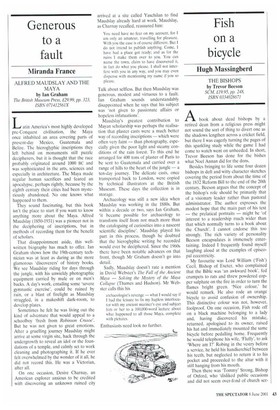Generous to a fault
Miranda France
ALFRED MAUDS LAY AND THE MAYA by Ian Graham
The British Museum Press, £29.99, pp. 323, ISBN 071412561X
Latin America's most highly developed pre-Conquest civilisation, the Maya once inhabited an area covering parts of present-day Mexico, Guatemala and Belize. The hieroglyphic inscriptions they left behind on monuments still puzzle decipherers, but it is thought that the race probably originated around 1000 BC and was sophisticated in the arts, sciences and especially in architecture. The Maya made regular human sacrifices and feared an apocalypse, perhaps rightly, because by the eighth century their cities had been mysteriously abandoned. No one knows what happened to them.
They sound fascinating, but this book isn't the place to start if you want to know anything more about the Maya. Alfred Maudslay (1850-1931) was a pioneer not in the deciphering of inscriptions, but in methods of recording them for the benefit of scholars.
That disappointment aside, this wellwritten biography has much to offer, Ian Graham shows how the 19th-century technician was at least as daring as the more glamorous 'discoverers' of history books. We see Maudslay riding for days through the jungle, with his unwieldy photographic equipment carried by mule or on men's backs. A day's work, entailing some 'severe gymnastic exercise', could be ruined by rain, or a blast of firelight as Maudslay struggled, in a makeshift dark-room, to develop plates.
Sometimes he felt he was living out the kind of adventure that would appeal to a schoolboy 'fresh from Robinson Crusoe'. But he was not given to great emotions. After a gruelling journey Maudslay might arrive at some virgin site, hack through the undergrowth to reveal an idol or the foundations of a temple, and calmly set to work cleaning and photographing it. If he ever felt overwhelmed by the wonder of it all, he did not record this. He was a Victorian, after all.
On one occasion, Desire Charnay, an American explorer anxious to be credited with discovering an unknown ruined city arrived at a site called Yaxchilan to find Maudslay already hard at work. Maudslay, as Charnay recalled, reassured him:
You need have no fear on my account, for I am only an amateur, travelling for pleasure. With you the case is of course different. But I do not intend to publish anything. Come, I have had a place got ready; and as for the ruins I make them over to you. You can name the town, claim to have discovered it. In fact do what you please. I shall not interfere with you in any way, and you may even dispense with mentioning my name if you so please.
Talk about selfless. But then Maudslay was generous, modest and virtuous to a fault. Ian Graham sounds understandably disappointed when he says that his subject was not given to passionate affairs or hopeless infatuations'.
Maudslay's greatest contribution to Mayan scholarship was perhaps the realisation that plaster casts were a much better way of recording inscriptions — which were often very faint — than photography, especially given the poor light and steamy conditions of the rain forest. To this end he arranged for 400 tons of plaster of Paris to be sent to Guatemala and carried over a range of hills to the heart of the jungle — a ten-day journey. The delicate casts, once transported back to London, were copied by technical illustrators at the British Museum. These days the collection is in storage.
Archaeology was still a new idea when Maudslay was working in the 1880s. But within a decade or two, says Ian Graham, 'it became possible for archaeology to transform itself from not much more than the cataloguing of curiosities into a nascent scientific discipline'. Maudslay played his part in this process, though he doubted that the hieroglyphic writing he recorded would ever be deciphered. Since the 1960s there have been notable advances on that front, though Mr Graham doesn't go into Sadly. Maudslay doesn't rate a mention in David Webster's The Fall of the Ancient Maya — Solving the Mystery of the Maya Collapse (Thames and Hudson). Mr Webster calls this his
archaeologist's revenge — what I would say if I had the leisure to fix my hapless interlocutor with my ancient mariner's eye and subject him or her to a 100,000-word lecture about what happened to all those Maya, complete with pictures.
Enthusiasts need look no further.






















































































 Previous page
Previous page